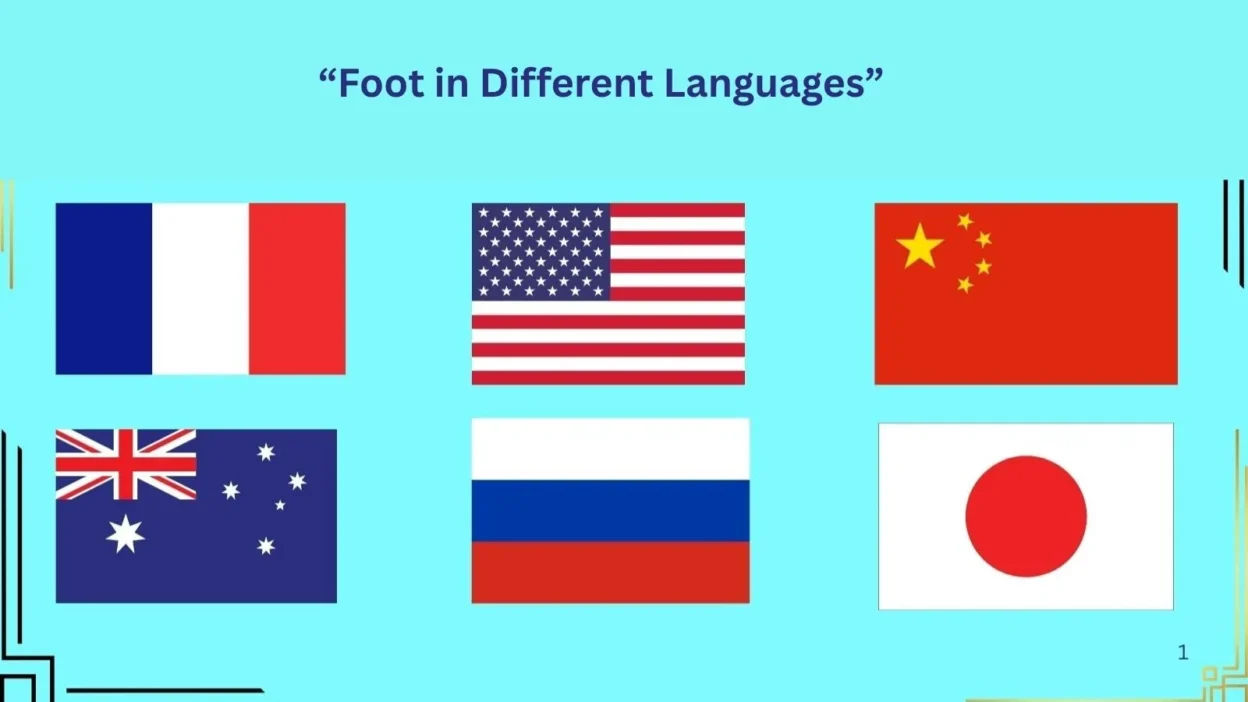Why Are You Searching for “
Have you ever found yourself wondering how to say the word “foot” in other languages? Maybe you’re a language learner, a traveler, a medical professional, or just someone curious about anatomy across cultures. No matter the reason, your search brought you here—and you’re in the right place.
This blog will solve your problem by:
- Explaining the meaning of the word “foot”
- Showing you how to use it in real-life conversations
- Listing its translation in 100+ languages
By the end of this article, you’ll feel more confident using the word “foot” in multilingual contexts—whether it’s for travel, translation, teaching, or simple curiosity.
What Does “Foot” Mean?
The word foot has two main meanings:
- Anatomical Meaning:
The lower part of the leg below the ankle, used for standing and walking.
- Example: “I hurt my foot while hiking.”
- Example: “I hurt my foot while hiking.”
- Measurement Unit:
A unit of length (plural: feet) used mainly in the United States, equal to 12 inches or approximately 30.48 cm.
- Example: “The table is six feet long.”
- Example: “The table is six feet long.”
In this blog, our focus is on the anatomical meaning of foot as a body part.
Why People Need This Word in Other Languages
There are many scenarios where you might need to know the word “foot” in another language:
- Traveling abroad and visiting a doctor or describing pain
- Learning new languages and expanding your vocabulary
- Teaching anatomy or health to multilingual students
- Translating books or documents about the human body
- Engaging in cultural conversations or studies
No matter your reason, knowing this common body part in different languages will help you connect with people better.
“Foot” in 100 Different Languages
Here is how you say “foot” (body part) in 100 languages:
| Language | Translation |
| Arabic | قدم (qadam) |
| Spanish | pie |
| French | pied |
| German | Fuß |
| Italian | piede |
| Russian | нога (noga) |
| Chinese (Mandarin) | 脚 (jiǎo) |
| Japanese | 足 (ashi) |
| Korean | 발 (bal) |
| Hindi | पैर (pair) |
| Urdu | پاؤں (paon) |
| Turkish | ayak |
| Portuguese | pé |
| Greek | πόδι (pódi) |
| Swahili | mguu |
| Hebrew | רגל (regel) |
| Bengali | পা (pa) |
| Tamil | காலை (kaalai) |
| Polish | stopa |
| Dutch | voet |
| Thai | เท้า (tháao) |
| Vietnamese | bàn chân |
| Indonesian | kaki |
| Filipino (Tagalog) | paa |
| Malay | kaki |
| Nepali | खुट्टा (khuṭṭā) |
| Finnish | jalka |
| Swedish | fot |
| Danish | fod |
| Norwegian | fot |
| Czech | noha |
| Slovak | noha |
| Hungarian | láb |
| Romanian | picior |
| Croatian | stopalo |
| Serbian | стопало (stopalo) |
| Bosnian | stopalo |
| Ukrainian | нога (noha) |
| Lithuanian | pėda |
| Latvian | pēda |
| Estonian | jalg |
| Persian (Farsi) | پا (pā) |
| Pashto | پښه (pakhā) |
| Kurdish | ling |
| Armenian | ոտք (votk’) |
| Georgian | ფეხი (pekhi) |
| Mongolian | хөл (khöl) |
| Lao | ຕີນ (tin) |
| Khmer | ជើង (cheung) |
| Sinhala | පාදය (pādaya) |
| Maori | waewae |
| Zulu | unyawo |
| Xhosa | unyawo |
| Afrikaans | voet |
| Haitian Creole | pye |
| Malagasy | tongotra |
| Igbo | ụkwụ |
| Yoruba | ẹsẹ |
| Hausa | ƙafa |
| Somali | lug |
| Amharic | እግር (əgəru) |
| Albanian | këmbë |
| Slovene | stopalo |
| Icelandic | fótur |
| Maltese | sieq |
| Basque | oin |
| Galician | pé |
| Catalan | peu |
| Luxembourgish | Fouss |
| Azerbaijani | ayaq |
| Uzbek | oyoq |
| Kazakh | аяқ (ayaq) |
| Tajik | по (po) |
| Turkmen | aýak |
| Belarusian | нага (naha) |
| Chichewa | phazi |
| Tigrinya | እግሪ (’əgri) |
| Quechua | chaki |
| Aymara | chaka |
| Maori | waewae |
| Samoan | vae |
| Tongan | vae |
| Fijian | yava |
| Guarani | py |
| Nahuatl | xopilli |
| Navajo | kéé’ |
| Cherokee | ᎧᎾ (kana) |
| Cree | sîpihkw |
| Ojibwe | ozhitoon |
| Inuktitut | ᑕᕝᕙ (tavva) |
| Esperanto | piedo |
| Latin | pes |
| Irish | cos |
| Scottish Gaelic | cas |
| Welsh | troed |
| Cornish | troos |
| Breton | troad |
How to Use the Word “Foot” in Sentences
Here are some examples of how you can use the word foot across languages:
- English: My foot hurts.
- Spanish: Me duele el pie.
- German: Mein Fuß tut weh.
- French: J’ai mal au pied.
- Hindi: मेरा पैर दर्द कर रहा है।
These simple sentences help you describe discomfort, explain injuries, or talk about body parts when traveling or speaking to locals.
Conclusion
The word “foot” may seem like a small part of your vocabulary, but it plays a big role in daily conversation—especially when traveling, learning new languages, or communicating across cultures.
This article provided:
- The meaning and real-life usage of “foot”
- Its translation in 100+ languages
- Example sentences to apply in conversation
Now that you know how to say “foot” around the world, you’ll feel more confident whether you’re in a hospital in Tokyo or on a hike in the Andes.



